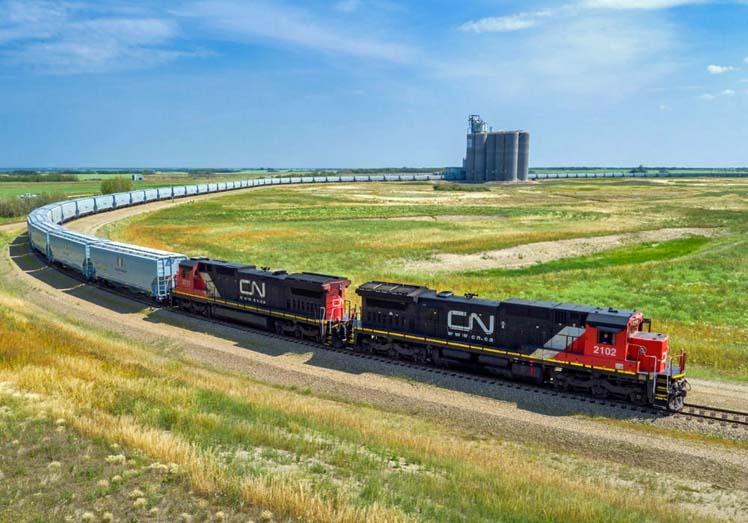
Saskatchewan, loop track power-on terminal - Date/Photographer unknown.

Grain Transport
Canada - The loop track power-on grain terminals popping up throughout the Prairies are kind of like the marines, no rail car gets left
behind.
That's one example of how these terminals improve efficiency in Canada's grain transportation system, said Warren Stow, president of Grains Connect Canada,
whose company is currently building two such facilities in Vegreville and Huxley and has two new, and identical, terminals in Saskatchewan.
Loop track power-on terminals can speed the loading and unloading process by up to 50 percent over conventional straight-track facilities, said
Stow.
Because the locomotive is never decoupled on loop tracks, the train never loses power and, in turn, braking pressure.
In the process, loop tracks remove two of the biggest inefficiencies in the grain transportation system, lengthy wait times, and partial hauling.
"With these terminals the trains never actually stop," said Stow.
"They don't have to decouple. They don't lose pressure. You don't have an eight-hour shift that brings a locomotive to an elevator to pull cars that are
left behind. It's super efficient."
That level of efficiency is driving the construction of new loop track terminals, including some at coastal ports.
Plans by the railway companies to increase the size of rail cars will necessitate the kind of capacity only loop tracks can provide, said Mark Hemmes,
president of Quorum Corporation, a company that monitors the grain transportation for the federal government.
However, this could be an uphill battle.
"There are lots of sunk costs in conventional terminals and not a heck of a lot of room for them to expand," said Hemmes.
"You can't turn any of those terminals at the coastal ports into a loop track just because of the constraints of the land. If you take a look at any of
the major terminals that are there right now, they do not have the real estate or the footprint to accommodate loop tracks."
How They Work
As their name suggests, trains arrive at these types of terminals and circle in a loop.
Unlike a conventional elevator, the railway staff leaves the locomotive while still running, with a crew from the elevator operating the train, which continues
to move along.
Loading at the elevator (or unloading at port) takes just four to five minutes per car.
"For 130 cars it takes less than 10 to 12 hours to load a full train, about half the time of a conventional elevator," said Stow.
"It's on the site for less than 12 to 18 hours. The fastest that a conventional elevator can load a full train is approximately 24
hours."
At conventional straight-track terminals, the rail crew disconnects the locomotive from the cars so it can be utilized elsewhere.
But it's not just the taking away the locomotive and bringing another back that slows the process.
"At a regular elevator, the railway staff decouples the locomotive from the cars, which causes loss of power and air pressure to the braking system,"
said Stow.
"When it's really cold it's extremely hard to get that pressure back up because you just can't build enough air pressure when it's -20 C or
-30 C.
With a conventional elevator you either take a very, very, long time to get the air pressure back up, or you just end up taking part of the train.
If you only have 60 cars pressured up, you take that 60 and leave 40 behind.
"Those are the kind of decisions the railway has to make when it gets really cold."
Loop tracks eliminate "one of the main inefficient pieces of the puzzle," he said.
"You don't have an eight-hour shift in which cars don't actually move at all because the crew spent their entire shift trying to pressurize the
brakes."
That adds up to major time savings in the grain transportation, David Przednowek, director of grain at CN, said in an email.
"If overall cycle time can be reduced by one or two days per trip, that translates into weeks over the course of the crop year, meaning more trips
achieved with that unit train set, and that means more grain movement," he said.
More Coming
More of these loop track power-on terminals are being built across the Prairies.
Paterson Grain recently added a new loop track facility in Bowden in addition to its units in Dunmore, Daysland, and Gleichen.
As well, G3 Canada plans to build eight new loop track facilities by 2020 and has already announced two Alberta sites, one in Wetaskiwin is already under
construction and work on another one in Carmangay will begin shortly.
Two such facilities have already opened in Saskatchewan (with a third under construction) and the Winnipeg-headquartered company is also building a loop track
terminal at Port Metro Vancouver.
Stow hinted at a similar development that Grains Connect has in the works.
"We are working on a solution on the West Coast for an outlet as efficient as our up-country facilities, with the same kind of unloading and loop-direct
capabilities at both ends," he said.
"Our plan is to have trains running back and forth in eight to 12 days site to site."
The development of loop tracks at coastal ports will further enhance efficiency, said Przednowek.
"The only loop track destination in Canada at present is MobilEx's facility in Thunder Bay. When G3's export terminal opens on the North Shore of
Vancouver, it will be served directly by CN and it will mark a further evolution of the grain supply chain, the loop-to-loop model."
Challenges Going Forward
Although loop track power-on systems are beneficial, they are not a one-and-done solution, said Hemmes.
In fact, loop tracks are just one component (albeit a major one) of a two-pronged plan the railways wish to put in place over the next decade.
"Over the next 10 years, the railways want to increase the size of rail cars from approximately 4,750 cubic feet to 5,300 cubic feet," said
Hemmes.
"These cars will probably be able to accommodate at least another 10 tonnes per rail car. Both railways are planning on investing, CP actually has cars in
production that are at that scale right now."
The second prong is a transition from 112 car to 134 car trains, which CP wishes to do.
At this point the only kind of grain terminal that can accommodate that size of rail car is loop tracks.
This will push the industry to build these facilities at port in the face of significant logistical and real estate challenges, said Hemmes.
However, a conventional, straight-track facility is not easily converted to loop tracks.
"There's no way the grain companies are giving up those conventional terminal properties because they have invested hundreds of millions of dollars in
them," he said.
The same applies in the country.
Over the past two decades, grain companies have replaced old wooden elevators with high-throughput straight-track terminals.
That means lots of relatively new terminals with a lot of sunk costs that are not easily, or cheaply, converted.
"Those elevators built in the last 15 years or so could potentially last 100 years," said Hemmes.
"The grain companies are not going to bulldoze those elevators or mothball them. What they're going to have to do is expand the tracks which were
previously constructed to accommodate the 100 car to 112 car standard established in the 1990s."
None of these are reasons for the railway and grain industries to not invest in loop track power-on technology going forward, he added.
Rather, they're the growing pains of an industry facing new demands.
"It's just the reality of moving to the next plateau, so to speak, in terms of railway operations."
Jeff Melchior.
provisions in Section 29 of the Canadian
Copyright Modernization Act.

